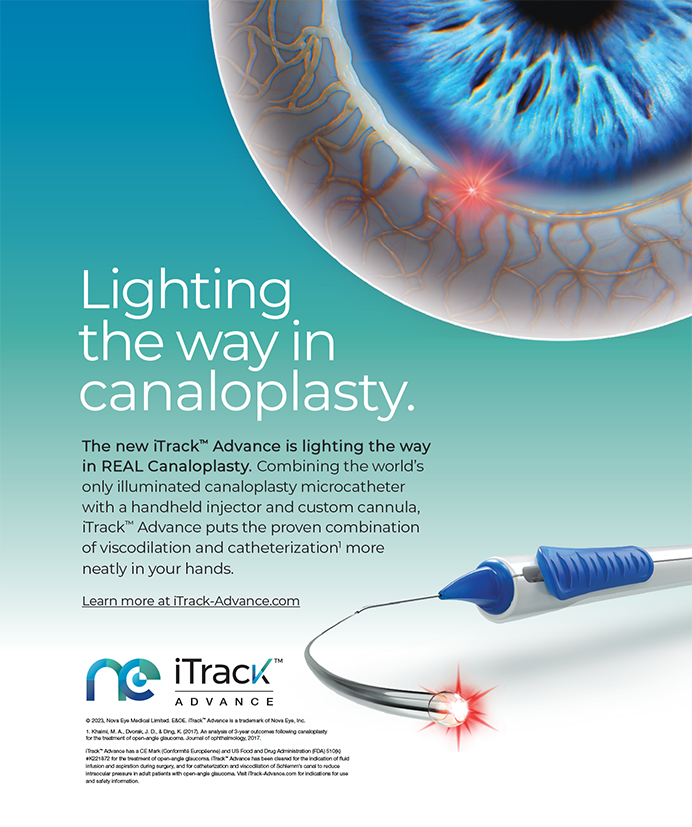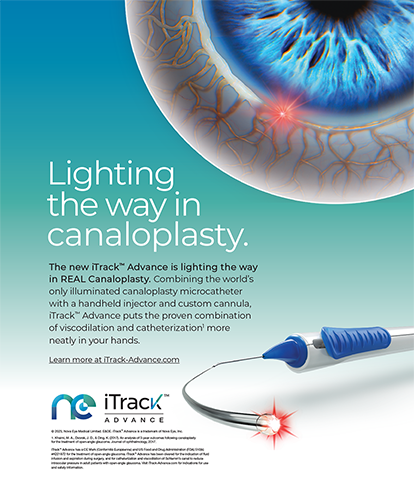CASE PRESENTATION
A 26-year-old woman who serves as an engineer with the Australian Defence Force presents for a refractive surgery consultation. The patient has anisometropia, a congenital cataract in the right eye, and probable amblyopia. She wears glasses most of the time but occasionally uses daily disposable contact lenses. Her hobbies include knitting and cycling. The patient’s history is significant for a retinopexy in the right eye to treat a tear.
Upon presentation, her corrected distance visual acuity is 6/6-1 OD with a manifest refraction of -6.25 -2.25 X 10º and 6/4.8-2 OS with a manifest refraction of -3.75 -1.50 X 175º. A small angle exophoria is well controlled with no evidence of diplopia or suppression. No dry eye disease is observed, and the patient has no history of eye rubbing.
Scotopic pupil measurements are 6.62 mm OD and 7.06 mm OS. An examination reveals a small congenital posterior lens opacity in the right eye and a clear lens in the left eye. A laser retinopexy scar and lattice degeneration are evident in the right eye. Corneal maps show mild thinning and steepening—albeit within normal limits—and the anterior chambers are deep (Figures 1 and 2). Specular microscopy reveals a normal corneal endothelium (Figure 3).

Figure 1. Preoperative measurements with the Pentacam (Oculus Optikgeräte) for the right (A) and left (B) eyes.

Figure 2. Preoperative measurements of the left eye with the Schwind MS-39 (CSO).

Figure 3. Preoperative specular microscopy of the corneal endothelium in each eye.
The patient is reluctant to undergo intraocular surgery on her “good” (ie, left) eye and prefers a minimally invasive approach to both eyes. How would you proceed?
—Case prepared by Abi Tenen, MBBS (Hons), FRANZCO

JACQUELINE BELTZ, MBBS (HONS), FRANZCO
I would recommend bilateral EVO ICL (STAAR Surgical) implantation, with surgery on the right eye followed by surgery on the left eye approximately 2 to 5 days later.
The thin corneas and inferior corneal steepening make me reluctant to offer laser vision correction (LVC). Surface ablation would be an option, with residual stromal beds in the vicinity of 336 and 386 µm, but the patient would still be at increased risk of developing postoperative corneal ectasia.
Given the moderately high refractive correction required and slightly abnormal corneas, ICL implantation would be a safer, more predictable strategy. I would explain to the patient that the implants can be removed when cataract surgery becomes necessary without negatively affecting the outcome of that procedure. In these respects, ICL surgery would be less invasive than LVC.
A third option would be to perform surface ablation on the left eye and ICL implantation in the right eye. I would strongly advise against this approach, however. In addition to the risk of ectasia, it could lead to ongoing comparisons of the vision in each eye by the patient and her dissatisfaction with one or both outcomes.

SHEETAL BRAR, MBBS, MS, FPRS, FC
Considering the complexity presented by the right eye, I would not recommend surgical intervention. I would not offer the patient corneal refractive surgery. Neither LASIK nor laser-assisted lenticule extraction (LALEX) could correct the entire refractive error because of the borderline corneal thickness, and PRK would pose the risks of haze and regression. Given her corrected distance visual acuity of 6/6-1 OD, the congenital cataract does not appear to be visually significant and thus could be safely monitored. The patient’s history of retinopexy makes me disinclined to offer intraocular surgery (phakic IOLs or cataract surgery), which could increase the risk of a retinal detachment in the future. I would therefore recommend she continue wearing a contact lens on the right eye because she tolerates it well and has expressed a preference for a minimally invasive approach.
I would offer to perform small-incision lenticule extraction (SMILE; Carl Zeiss Meditec) on the left eye. The pachymetry and topography measurements are suitable, and the residual bed thickness would be reasonable. The pupil size is large (7 mm), so a 6.8- to 7-mm optical zone would be created to reduce the postoperative incidence of glare. I would recommend SMILE over LASIK in this situation to minimize the induction of postoperative dry eye disease. The patient’s long-term use of contact lenses has likely already compromised the health of the ocular surface to some degree.

A. JOHN KANELLOPOULOS, MD
Because cataractous changes are present in the right eye, cataract surgery on this young patient may be warranted not too far in the future, so the procedure could be considered now. Otherwise, I would recommend bilateral EVO ICL implantation and hope her preference for minimally invasive intervention extends to this procedure. The advantages of ICL implantation are that it would bypass concerns about what I consider to be a suspicious corneal thickness pattern in the left eye and would keep the cornea intact for future lens surgery. I would prefer to avoid LVC in this situation.

AUDREY ROSTOV, MD
Epithelial mapping and tomography measurements of each eye would be obtained. Figure 1A shows mild asymmetric astigmatism with inferior steepening in the right eye. This may represent mild dry eye disease. Treatment with lifitegrast and preservative-free artificial tears would be initiated, and the patient would be asked to return in several weeks for repeat epithelial mapping and tomography. In addition, a cycloplegic refraction would be performed—especially important because she has anisometropia.
If the results of repeat testing are normal and her refraction is stable, the patient would be counseled on the options of LVC and EVO ICL implantation. She is a good candidate for both approaches.
Based on her refraction, the patient could do well with LALEX. LASIK could also be considered, but LALEX would be less invasive. Given her occupation in the military, moreover, LALEX would offer the advantage of avoiding potential late complications related to a flap.
ICL implantation would not change the corneal curvature, which will be important for future biometry for cataract surgery. This may be an important consideration because she will need cataract surgery in the future—potentially sooner in the right eye due to the congenital cataract. The patient is reluctant to undergo intraocular surgery on the left eye. One option would be to perform LALEX on the left eye and ICL implantation on the right eye. If the patient chooses this approach, the ICL procedure on the right eye would be performed first. She would then be given the choice of undergoing ICL implantation or LALEX (specifically SMILE) on the left eye.
When patients have differences between their eyes that can result in different approaches, as in this situation, I perform surgery on the first eye, evaluate how they are doing and feeling about the first procedure, and offer the same procedure for the second eye if appropriate. This patient is reluctant to undergo intraocular surgery in the left eye. If ICL implantation on the right eye is successful, however, she might feel comfortable undergoing the same procedure on the left eye as well. Alternatively, SMILE could be performed bilaterally if she prefers to undergo the same procedure on both eyes and avoid intraocular surgery and if calculations indicate an adequate residual stromal bed. My minimum is 260 µm, whereas Carl Zeiss Meditec specifies 250 µm.

WHAT I DID: ABI TENEN, MBBS (HONS), FRANZCO
As my colleagues’ different approaches to this case show, medicine is an art, not just a science. This is why discussing tricky situations with peers is so interesting.
The patient’s optometrist had given her the impression that the only option for her right eye was cataract surgery. Her retina surgeon, however, had previously cautioned her to avoid cataract surgery if possible and warned her against applied suction to the right eye with corneal laser procedures. Key challenges in this situation were the advice that the patient had received from other practitioners regarding suitable surgery and her resultant confusion and concern.
I counseled the patient that I would provide an independent opinion and said she should proceed with me only if she felt truly comfortable with my suggested plan.
Cataract surgery was unlikely to improve her BCVA. Moreover, the procedure would have increased her risk of additional retinal problems and might have weakened the posterior capsule, which would have increased the risk of complications. I therefore decided not to pursue cataract surgery on the right eye. The cornea was also too thin for LVC. The congenital lens opacity, however, was posterior only and therefore had less effect on her candidacy for an EVO ICL than other types of lens opacities would.
Ultimately, I recommended the implantation of an EVO ICL in the right eye and either LASIK or LALEX (specifically SMILE) in the left eye. The patient underwent LASIK 2 weeks before ICL implantation. An 8.8-mm LASIK flap with large optical and blend zones was used in the left eye to avoid nighttime aberration symptoms around lights. All surgical procedures were uneventful.
The patient’s UCVA was 6/6 OD, 6/5 OS, and 6/4.8 OU immediately postoperatively. Her uncorrected near visual acuity was N5 OU. She was thrilled with her result and sensed no asymmetry between the visual acuity of her eyes.
This case illustrates the importance of developing an individualized treatment plan that fits both the surgeon’s and the patient’s desires. Refractive surgery is elective, so patients must feel comfortable with the surgical plan before its execution.




